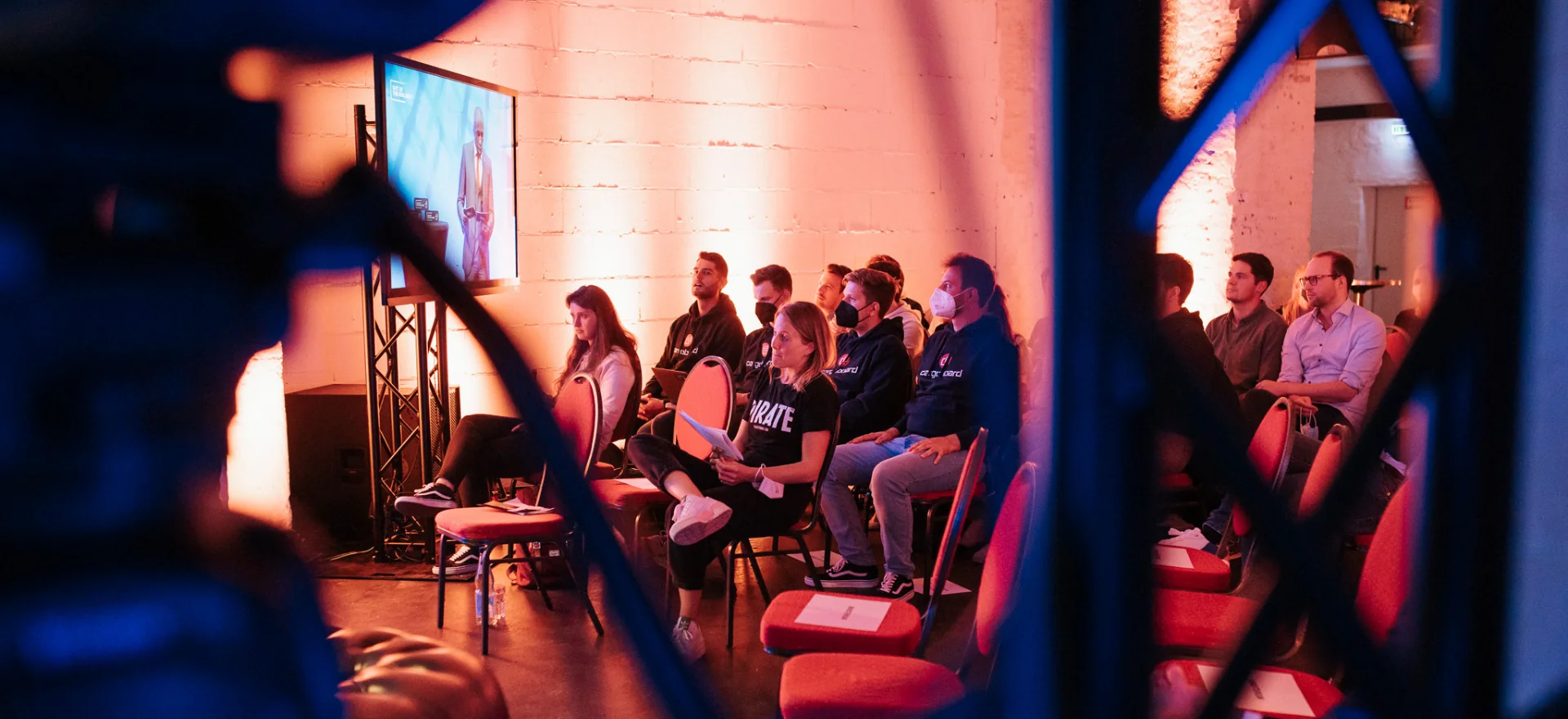5 Starting Points to Make Your Event Hybrid
If you’ve been paying attention to the event industry lately, you might have heard the terminology “hybrid event” over and over. But what exactly is a hybrid event?
Here, we’ll share why it is not always so straightforward to define the term “hybrid event”, but also why the definition is not always so important. In this blog article, we’ll explore five different ways you can build hybrid elements into your event, and enrich the experience for your participants.
There is no one definition for a “hybrid event”. The term “hybrid” event means something different depending on your viewpoint. Rather than thinking of it as a type of event format, rather it’s an adjective that can refer to many parts of your event concept. Let’s examine how we can apply this term to each element of the event concept.
1- Hybrid production (speakers, moderators)
Our first example is a hybrid production. In this case, we describe a situation where your event’s content creation takes place on location, separate from your participants. This may include a production studio, where your speakers, moderators and actors involved in the program and production are choreographed and produced. In a hybrid production, your participants and audience join in a digital capacity.
But what if you want to bring some of your audience on location? This brings us to our next example.
2- Hybrid live audience
In this example, your participants are gathered partly in your physical location, and partly remotely. For many organizers, a hybrid live audience is often the classic understanding of a hybrid event.
One well-known example of this is live sporting events, where some participants are joining physically in the stadium, and others may be watching on television. This setup is the premier class of event conception, both in terms of design, and cost. This is because our target group has two characteristics, and subsequent participation needs.
As we’ve shared previously, your event concept, and promise to your participants should adhere to where, and how they are joining your event. To continue the example, the needs of the participants in the stadium are different from those joining at home. Attendees joining digitally require certain adjustments to ensure that they will have the best experience out of your event. A fixed perspective livestream does not offer the best experience for these participants. In the sports example, broadcasters include different camera angles, closeups, replays, and enhanced commentary to enliven the at-home viewing experience. If you welcome a hybrid audience to your event, you should be thinking in exactly the same way. Always consider, how can I utilize technology to enhance the experience for our remote participants? If you are unable to offer an enhanced experience for attendees joining virtually, you might want to reflect these changes in your ticket prices, or your marketing and messaging. Additionally, you may consider including different virtual elements for your remote participants, that can only be experienced in a digital setting, such as virtual demonstrations or interactive sessions.
3- Hybrid content (time synchronous/live vs. online/on demand)
The next example of a hybrid event is the example of hybrid content. When it comes to content, organizers have more options and opportunities than ever before. For example, you can combine live content, with elements that are pre-recorded. Your speakers and talent can appear on location, or they can be broadcasted to your location virtually, or possibly as a hologram. By combining live and pre-recorded elements, organizers can simplify their program planning and prevent surprises on the day.
When it comes to deciding your content, consider what type of content production makes the most sense for your audience and the value that they will derive from the event. What role should the audience play? Will there be interactive elements? Some types of content, such as educational or informational content, may be delivered more effectively in a pre-recorded format. Whereas others, such as entertainment, may better be presented live.
Consider how you will engage your audiences. Presentations that depend on audience engagement will likely need to be delivered live, whereas, for other types of content, organizers have more options. For example, if you wish to provide the opportunity for question and answer sessions, you may choose to pre-record sections in advance, and a live Q&A session afterward.
Organizers should use these new presentation options to their advantage. Just because it’s an event, not everything has to be live on the day. In fact, many types of content can benefit from being produced in advance! Choose what’s right for your audience.
4- Hybrid sponsorship & exhibition marketplace (on site vs online)
The next aspect where we can apply “hybrid” is to your sponsorship and exhibition marketplace. Here, what is most important is to find a solution for your sponsors and attendees that brings the most value to each stakeholder in your event.
For organizers, it’s important to ask if all partners require a physical presence on site or a digital one? And how does this reflect in the pricing of your partner packages?
Be clear with your partners about the options they may have, and that user behavior both online and offline may be different. For some sponsors, a digital presence may be preferable, where it is easier to capture impressions and attendee activity. For others, a physical presence may be more important, to share the products on offer (provide samples, etc…).
For organizers, it’s important to understand how partner areas and booths will be set up and structured. What is included in the online profiles? Who will be responsible for setting up the profiles? What are the different ways that sponsors can participate in your event? You notice that the aspect of “hybrid sponsoring and exhibition concepts” in particular brings an incredible amount of dynamism into it.
5- Hybrid networking formats (speed dating, matchmaking)
When your event takes place in a physical location, networking is more or less straightforward. Sometimes it takes place in a conscious way, and sometimes a bit more randomly. But how is it possible to network effectively when some participants are online, and others, onsite?
Networking formats can also be designed in a hybrid manner. To do this effectively, you will need to create an appropriate venue to link your participants together. Most often, this can be done with your event app or platform, which will help serve as a directory and also facilitate meeting requests or digital chat conversations. When both in-person and virtual attendees connect on the same platform, they can continue their conversations either online, or if they happen to both be at the venue, in person.
Organizers can get creative when it comes to designing aspects of their event for hybrid networking. One example might include “business speed dating” where different people can be connected randomly in the venue and outside of it using an onsite networking space, equipped with appropriate hardware that can connect with off-site participants.
Closing Thoughts
Overall, it is important when thinking of hybrid events to realize that a hybrid event does not refer to one type of event. Rather, it opens numerous possibilities of how you can incorporate digital elements into your event concept. You can mix and match based on your preferences and, importantly– what suits your participants best. Each organizer, and each event, has the opportunity to develop their own definition of hybrid.
And if you have any questions– please feel free to reach out to me– here. I’d be more than happy to answer them.

Written by:
Frederic Bleck
PIRATEx Head of New Business

